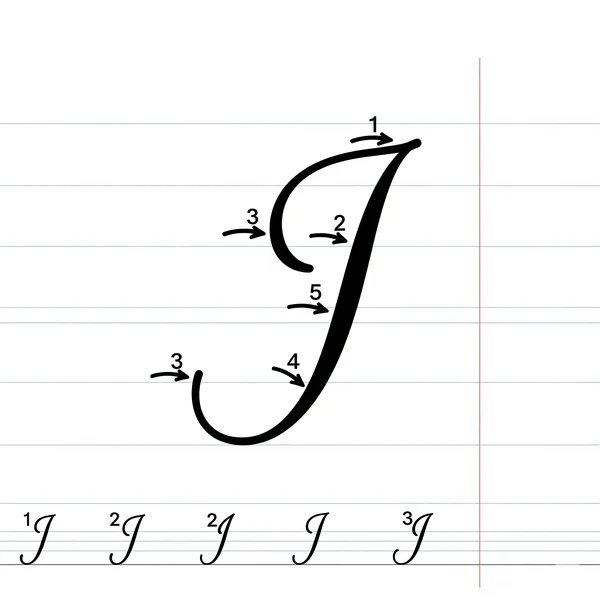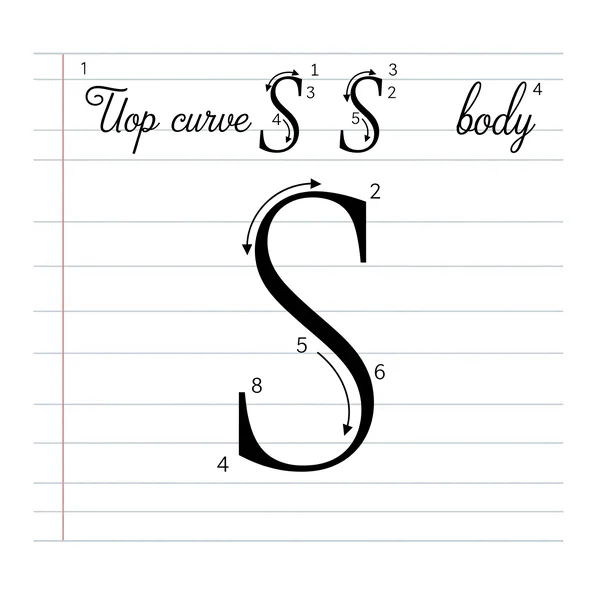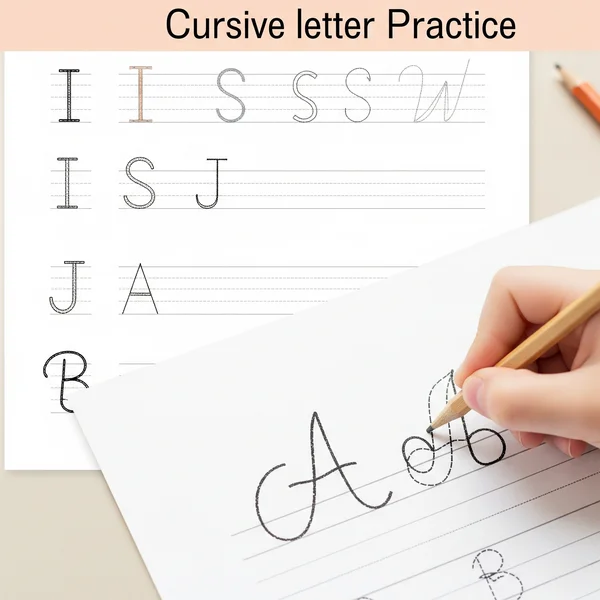Cursive Capitals Made Easy: Mastering Uppercase I, S, J
You've diligently practiced your lowercase cursive alphabet, and your connections are getting smoother. Now it's time to tackle the majestic uppercase cursive alphabet! While capital letters in cursive add flair and formality to your writing, some can seem a bit daunting. Are cursive capitals hard to learn? Not with the right guidance! This guide will make Cursive Capitals Made Easy, with a special focus on mastering uppercase letters like the often-tricky I, S, and J, plus tips for the rest. Ready to complete your cursive journey? For a full overview of all letterforms, you might want to consult our complete cursive alphabet chart.
Mastering Cursive Capitals: Easy Techniques for Uppercase I, S, J & Beyond
Learning the uppercase cursive alphabet is essential for proper sentence structure and writing names. While many capitals resemble their print counterparts more closely than lowercase letters do, they each have unique cursive forms and starting points. We'll break down the uppercase letter formation for some of the most commonly searched difficult capital letters and provide general principles to help you learn cursive uppercase with confidence.
Why Uppercase Cursive Letters Deserve Special Attention
Why focus specifically on capital letters in cursive? They play a crucial role in clear communication and elegant presentation.
Their Role in Sentences and Proper Nouns
Uppercase cursive letters mark the beginning of sentences and are used for proper nouns cursive (names of people, places, etc.). Correctly formed capitals ensure your writing adheres to grammatical conventions and looks polished.
Distinct Forms Compared to Lowercase
Unlike many lowercase cursive letters that flow directly from one to another, uppercase letters often stand slightly apart or have more elaborate initial strokes. Their larger size and sometimes more complex shapes require dedicated cursive writing practice.
General Tips for Writing All Uppercase Cursive Letters Neatly
Before we dive into specific letters, here are some universal cursive writing tips for all your capital letter drills:
Consistent Height and Proportion
Aim for your capital letters to be consistently taller than your lowercase x-height letters, typically reaching the top line of your ruled paper. Maintain proportional width for elegant capital letters.
Understanding Starting Points and Stroke Direction
Each capital letter has a specific starting point and stroke sequence. Referring to a good cursive alphabet chart is crucial for learning these correctly. Many uppercase letter formation challenges stem from incorrect starting points.

Most Capitals Do Not Connect to Lowercase Letters
A key rule: in most standard cursive styles, uppercase letters do not connect to the first lowercase letter of the word. You lift your pen after completing the capital and start the lowercase letter closely beside it.
How to Write Big I Cursive: A Step-by-Step Guide
The cursive capital I can be confusing as it often resembles a print 'I' or a more elaborate flourish. How to write capital I in cursive? Let's look at a common, practical form.
The Common "Print-Like" Cursive Capital I
- Start: Begin a little below the top line with a small, slightly curved upstroke or a small loop to the left.
- Main Stroke: From the top of this initial stroke (or loop), draw a straight or slightly curved diagonal line downwards and to the right, extending to the baseline.
- Finishing Touches (Optional): Some styles add small horizontal strokes (serifs) at the very top and bottom of this main diagonal stroke. For a simpler
big I cursive, these can be omitted.
(Optional) More Flourished or Traditional Capital I Variations
More historical cursive styles might feature a more elaborate, looped cursive capital I, often starting with a large sweeping curve from the left. If you're learning a specific style, consult its unique forms.
Practice Drills for the Cursive Capital I
Practice writing rows of the Capital I, focusing on a consistent slant and starting point. Then, write names starting with 'I' (e.g., "Ian," "Ireland") to practice its use. You can find dedicated practice sheets for capital letters here.

Conquering the Cursive Capital S: Form and Flow
The cursive capital S is another of the difficult capital letters for many. How to write capital S in cursive?
The Initial Upstroke and Top Curve
- Start: Begin near, or slightly above, the baseline with an upward, curving stroke that sweeps towards the top line.
- Top Curve: As you approach the top line, curve sharply to the left and slightly downwards, forming the top part of the 'S'.
Forming the Main Body and Lower Curve
- Body: Continue the stroke downwards and to the right, creating a diagonal or slightly curved line that forms the main body of the 'S'. This stroke should cross your initial upstroke.
- Lower Curve: As you near the baseline again, curve to the left and then slightly upwards to finish the letter. Some styles add a small loop or a simple up-tick at the end.
Common Pitfalls with the Cursive Capital S
Avoid making the 'S' too narrow or too wide. Ensure the top and bottom curves are proportional and that the crossover point is clear. Consistent cursive writing practice is key.

Nailing the Cursive Capital J: Loops and Descenders
The cursive capital J is distinctive due to its descender loop. How to write capital J in cursive?
The Top Loop or Starting Flourish
- Start: Begin near the top line (or slightly below for some styles) with a small loop or a decorative flourish that sweeps to the right.
- Main Downstroke: From this starting point, draw a straight or slightly curved line downwards, extending well below the baseline.
The Descending Stem and Bottom Loop
- Descender: This is the part of the 'J' that goes below the baseline.
- Bottom Loop: Form a loop to the left below the baseline, then bring the stroke upwards, crossing the main descending stem typically at or slightly above the baseline.
Ensuring the Descender is Proportional
The descender loop should be a good size – not too cramped and not overly exaggerated, maintaining balance with the upper part of the letter. Referencing a cursive alphabet chart can help with proportions.

A Quick Look at Other Notable Uppercase Cursive Letters
While I, S, and J are common hurdles, here's a glance at other uppercase cursive alphabet groups:
Loop-Based Capitals (e.g., L, D)
Letters like 'L' and 'D' often feature prominent initial loops. Mastering loop control is key for these elegant capital letters.
Capitals with Similar Starting Strokes (e.g., C, E, G)
These letters often begin with a similar curved or looped starting stroke from the top or mid-zone.
Pointed or Angular Capitals (e.g., A, M, N)
These capitals rely more on straight lines and defined angles rather than prominent loops. Uppercase letter formation here is about precision.
Referring to a Complete Cursive Alphabet Chart
For a comprehensive view of all cursive capitals A-Z, always refer to a reliable cursive alphabet chart. This is an invaluable tool as you learn cursive uppercase. You can find a detailed chart on our learning portal.
Practice Strategies for Mastering Your Capital Letters in Cursive
How to practice uppercase cursive? Effective practice is crucial.
Isolate and Practice Difficult Capital Letters
Dedicate specific practice sessions to the difficult capital letters you struggle with. Write rows of just that letter until you feel more confident.
Writing Names and Starting Sentences
Once individual capitals are improving, practice writing names of people, cities, and countries, as well as starting sentences. This puts them into a practical context.
Using Uppercase Cursive Worksheets
Specialized cursive writing practice sheets for capital letters in cursive provide tracing guides and space for freehand practice, reinforcing correct uppercase letter formation.

Confidently Write Your Cursive Capital Alphabet
Mastering uppercase letters is a significant milestone in your cursive journey. By understanding the general principles, focusing on the step-by-step formation of tricky letters like I, S, and J, and dedicating time to consistent capital letter drills, you can write the entire cursive capital alphabet with elegance and confidence. Remember, patience and persistent cursive writing practice are your best allies.
Which uppercase cursive letter do you find most challenging to write? Share your experiences or tips in the comments below! To further your skills, consider exploring our extensive cursive practice resources.
Frequently Asked Questions About Uppercase Cursive Letters
Let's address some common queries about capital letters in cursive:
Do uppercase cursive letters always look the same in different styles?
No. While there are common foundational forms, the exact appearance of uppercase cursive letters, especially their flourishes and decorative elements, can vary significantly between different cursive handwriting styles (e.g., Spencerian vs. Palmer vs. modern simplified).
Should my cursive capital letters touch the line above?
Most cursive capital letters should reach the top line of your writing paper. Some very elaborate flourishes might extend slightly beyond, but the main body of the letter typically stays within the standard writing lines shown on a cursive alphabet chart.
How do I connect a cursive capital if it's in the middle of a word (e.g., acronyms)?
Do uppercase cursive letters connect? Generally, no. In true cursive flow, if an uppercase letter appears mid-word (which is rare, usually only for acronyms like USA), you would typically lift your pen after the preceding lowercase letter, write the capital, lift again, and then write the following lowercase letter. Standard capital letters in cursive are not designed to connect from a preceding lowercase letter or to a following one.
Are there simpler versions of some difficult capital letters?
Yes, many modern cursive alphabet styles offer simplified versions of traditionally more complex capitals. If you're struggling with a highly ornate form, look for a more streamlined alternative that prioritizes legibility. Our guides aim to teach clear and accessible uppercase letter formation.